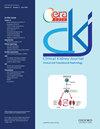Cystatin C vs Creatinine eGFR in Advanced CKD: an analysis of the STOP-ACEi Trial
IF 3.9
2区 医学
Q1 UROLOGY & NEPHROLOGY
引用次数: 0
Abstract
Background and hypothesis In this secondary analysis of the STOP-ACEi trial, we explored the impact of discontinuing or continuing renin angiotensin system inhibitor therapy in people with advanced chronic kidney disease on cystatin C estimated glomerular filtration rate. Methods Cystatin C eGFR were calculated at baseline, 12-, 24- and 36-months using CKD-EPI Cystatin 2012, EKFC and CKD-EPI Combined 2021 equations. We excluded samples obtained after the initiation of kidney-replacement therapy. Primary analysis used complete case analysis and mixed-effects linear regression model, adjusting for minimization variables, baseline value, time-point, and treatment by time interaction. Sensitivity analysis was conducted using a pattern mixture model to account for missing data that was not at random. To model the longitudinal cystatin C data with time-to-event data, a joint model was utilized which incorporated the cystatin C measurements at various time points and accounted for the occurrence of kidney replacement therapy. Results The mean cystatin C eGFR (CKD-EPI 2012) at baseline were 17.8 mg/L [SD: 6.3] and 17.9 ml/min/1.73m2 [SD: 6.3] in the STOP and CONTINUE arms respectively. The estimated least squares mean difference at 12 months between STOP and CONTINUE arm was -1.46 (95% CI: -2.39 to -0.52, p=0.002). The estimated least squares mean difference at 24 months was -2.27 (95% CI: -3.48 to -1.06, p<0.001). The estimated least squares mean difference at 36 months was -1.72 (95% CI: -3.48 to 0.03, p=0.05). Conclusion Our results are consistent with the primary study's analysis and sensitivity analyses support these findings and provide additional insights. Our findings demonstrate the similarity of creatinine and cystatin eGFR results and therefore support the use of cystatin C as an alternative marker of eGFR in advanced CKD, particularly in those whom creatinine is likely to be less accurate.晚期慢性肾功能衰竭患者的胱抑素 C 与肌酐 eGFR:STOP-ACEi 试验分析
背景与假设 在这项 STOP-ACEi 试验的二次分析中,我们探讨了晚期慢性肾脏病患者停止或继续肾素血管紧张素系统抑制剂治疗对胱抑素 C 估计肾小球滤过率的影响。方法 使用 CKD-EPI Cystatin 2012、EKFC 和 CKD-EPI Combined 2021 方程计算基线、12、24 和 36 个月的胱抑素 C eGFR。我们排除了开始肾脏替代疗法后获得的样本。初步分析采用了完整病例分析和混合效应线性回归模型,并对最小化变量、基线值、时间点和治疗与时间的交互作用进行了调整。使用模式混合模型进行了敏感性分析,以考虑非随机缺失数据。为了将纵向胱抑素 C 数据与时间到事件数据进行建模,使用了一个联合模型,该模型纳入了不同时间点的胱抑素 C 测量值,并考虑了肾脏替代疗法的发生情况。结果 停止治疗组和继续治疗组基线时的胱抑素 C eGFR(CKD-EPI 2012)平均值分别为 17.8 mg/L [SD: 6.3] 和 17.9 ml/min/1.73m2 [SD: 6.3]。STOP 和 CONTINUE 两组在 12 个月时的估计最小二乘法均值差异为-1.46(95% CI:-2.39 至-0.52,P=0.002)。24 个月时的估计最小二乘法平均差为-2.27(95% CI:-3.48 至-1.06,p<0.001)。36 个月时的估计最小二乘法平均差为-1.72(95% CI:-3.48 至 0.03,p=0.05)。结论 我们的结果与主要研究的分析一致,敏感性分析支持这些发现,并提供了更多的见解。我们的研究结果证明了肌酐和胱抑素 eGFR 结果的相似性,因此支持使用胱抑素 C 作为晚期 CKD 患者 eGFR 的替代指标,尤其是肌酐可能不太准确的患者。
本文章由计算机程序翻译,如有差异,请以英文原文为准。
求助全文
约1分钟内获得全文
求助全文
来源期刊

Clinical Kidney Journal
Medicine-Transplantation
CiteScore
6.70
自引率
10.90%
发文量
242
审稿时长
8 weeks
期刊介绍:
About the Journal
Clinical Kidney Journal: Clinical and Translational Nephrology (ckj), an official journal of the ERA-EDTA (European Renal Association-European Dialysis and Transplant Association), is a fully open access, online only journal publishing bimonthly. The journal is an essential educational and training resource integrating clinical, translational and educational research into clinical practice. ckj aims to contribute to a translational research culture among nephrologists and kidney pathologists that helps close the gap between basic researchers and practicing clinicians and promote sorely needed innovation in the Nephrology field. All research articles in this journal have undergone peer review.
 求助内容:
求助内容: 应助结果提醒方式:
应助结果提醒方式:


